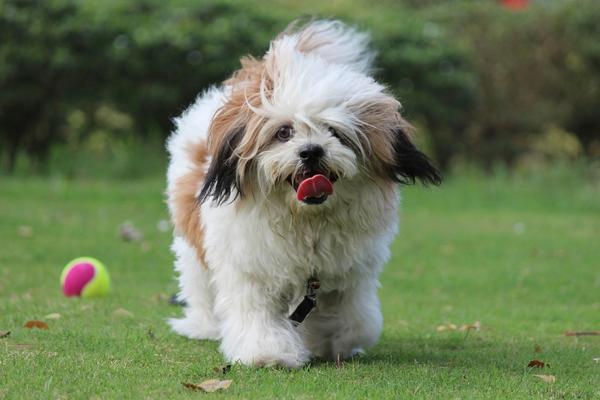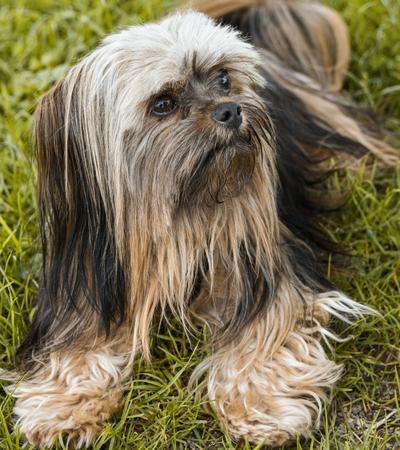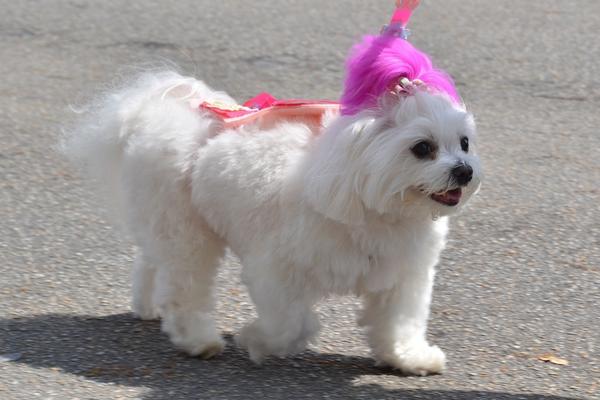Small, long-haired dogs like the Lhasa Apso and Maltese make cute and cuddly canine companions. Both dogs have long, flowing, hypoallergenic coats and share many other similarities.
However, the Maltese and Lhasa Apso may look alike, but there are some key differences between these two small breeds. To help you decide which breed is the one for you, we’ve compared the Lhasa Apso and Maltese in detail.
Want to know which dog is easiest to train, or more expensive? Curious to know which canine needs the most grooming or daily exercise? If so, keep reading — we have all the answers.
Lhasa Apso or Maltese Comparison Chart
Lhasa Apso
Maltese
Personality
Loyal
Affectionate
Independent
Intelligent
Stubborn
Wary of strangers
Protective
Gentle
Loyal
Obedient
Eager to please
Protective
Playful
Affectionate
Family Dog
Yes
Yes
Height
10-11 inches
7-9 inches
Weight
12-18 pounds
Under 7 pounds
Cost
$500-$1200
$1000-$2500
Hypoallergenic
Yes
Yes
Lifespan
12-15 years
12-15 years
Coat Colors
White, Black, Tan, Brown, Gray, Golden, Combination
White
Trainability
Moderate
Independent and stubborn side that can make training challenging at times. Crate training recommended
Moderate
Obedient and intelligent, can learn new tricks and commands easily. Responds well to praise.
Lhasa Apso vs Maltese — The Breeds
Lhasa Apsos are small, long-haired dogs originating from Tibet. These canines were used as watchdogs for ancient monasteries and still make noisy protectors today.
Although small, they’re big on energy and character. Lhasas will love their owners unconditionally, but they aren’t fond of strangers. Expect your pooch to bark at unfamiliar guests, and be prepared for their stubborn streak during puppy training.
Is the Lhasa Apso for Me?
Lhasa Apsos are small and loyal companion dogs. If you have a small living space, this breed will easily fit into your home. Plus, they’re popular with seniors and also families. However, if you have young children, the Lhasa isn’t the best furry playmate for your family.
And, these dogs are ideal for those with busy lifestyles — they’re low-maintenance in the walkies department. This is also a good breed for people with allergies wanting a small, hypoallergenic dog.
Pros
- Loves spending time with owners.
- Loyal and protective.
- Hypoallergenic coat.
Cons
- Can be difficult to train.
- Barks a lot at strangers.
- Size can be an issue with young children.
Maltese dogs have their ancestry linked to the island of Malta, although their exact place of origin remains unknown. These small, white dogs have been around for thousands of years and can be dated back as far as ancient Egypt.
Protective of their owners, the Maltese demonstrates their loyalty by barking at strangers. They’re excellent tiny watchdogs, but their adorable appearance is unlikely to scare away any intruders.
The long and straight white hair of a Maltese is low shedding and requires frequent grooming. And, while this pint-sized pooch can turn heads with their striking coat, they also do well performing on the agility course.
Is the Maltese for Me?
A tiny dog with a lot of love to give, the Maltese is a perfect example of a hypoallergenic lap dog. Their toy size means they can squeeze into the smallest of living spaces, or suit apartment living.
Whether you’re a senior looking for a lap dog, or a young family looking for a furry friend, the Maltese will happily slot into your life. However, their tiny size means they can be injured easily. Therefore, they may not be the best choice for families with young children.
Maltese dogs are pretty low maintenance regarding exercise, but not for grooming. That show-stopping white coat needs a lot of attention.
Pros
- Doesn’t need much exercise.
- Small and compact size.
- Hypoallergenic coat.
- Loyal and affectionate temperament.
Cons
- Can have a stubborn side.
- Too small to live with young children.
- High-maintenance grooming needs.
Lhasa Apso vs Maltese Size
Both the Maltese and Lhasa Apso are small dogs, but there is a significant difference in their size. The tiny Maltese is both shorter and lighter than the Lhasa Apso.
When looking at the full grown Lhasa Apso vs Maltese:
- An adult Maltese will often weigh no more than 7 pounds and only grow to approximately 7 to 9 inches tall.
- The Lhasa Apso weighs in at around 12 to 18 pounds. These dogs are small but not tiny, reaching up to 11 inches tall.
Lhasa Apso vs Maltese Temperament
Lhasa Apsos and Maltese dogs share similar appearances, but their temperament can vary significantly.
Behavior
Nobody wants a naughty dog, right? Well, the good news is, neither of these dogs are badly behaved — when taken care of properly.
Maltese dogs are obedient and enjoy pleasing their owners. In comparison, Lhasa Apsos are known for being quite strong-willed and stubborn. Neither is fond of strangers, but the Maltese is a little more adaptable to new faces than the Lhasa.
Both of these dogs have affectionate, charming, and comical personalities. These dogs love to play, but their gentle nature means they enjoy snuggle time too.
Separation Anxiety
Having a dog that won’t leave your side is adorable, until you need to leave the house! The companionship and loyalty of these dogs come with a price — separation anxiety.
Neither the Lhasa Apso or Maltese enjoy being left alone. If you have to leave the house for several hours a day, your pooch will likely be very distressed in your absence. Separation anxiety can cause your dog to bark excessively, and they may misbehave in your absence.
Lhasa Apso vs Maltese Training
The Lhasa Apso and Maltese are small dogs with big intelligence. However, one of these breeds is much more obedient than the other.
Lhasa Apso
While Lhasas possess brain power, they’re known to be quite difficult to train at times. Their strong-willed nature can make training challenging. Crate training has proven effective for housebreaking Lhasa Apso pups.
Lhasa Apsos are clever enough to learn tricks and new skills, but obedience training should be the priority. Once your pooch is responding to basic behavioral commands, you can move on to the fun stuff!
During the challenges of puppy training, remember that positive reinforcement is always more effective than punishment. Lhasas will learn much quicker when praise and doggy treats are involved.
Maltese
Compared to the Lhasa Apso, Maltese dogs are fairly easy to train. These bundles of white fur love to please, and this eagerness to obey makes training a walky in the doggy park. Your Maltese will flourish with praise and fuss when they learn something new, the more positive the training approach, the better.
In fact, punishment and shouting will have the opposite effect, causing your Maltese to learn more slowly. When you start training your pooch from a young age, they will grow into an adaptable and happy pet.
Both the Maltese and Lhasa Apso can be yappy, so it’s important to teach them the ‘quiet’ command as early as possible.
Lhasa Apso vs Maltese Price
Dog prices vary significantly, and it’s difficult to give an exact cost for each of these breeds. Pedigree dogs from a champion bloodline, with all of their documentation, will come with a premium price tag.
Here’s what you can expect to pay:
- Lhasa Apso puppies cost approximately $500 to $1200.
- The Maltese starts from around $1000 up to $2500.
Lhasa Apso vs Maltese Shedding
If you have dog allergies, you’re probably keen to learn exactly how much these tiny dogs shed. The good news is that both the Lhasa Apso and Maltese are hypoallergenic. This means neither breed sheds enough fur to cause allergy symptoms.
Lhasa Apso
The Lhasa Apso has a floor-length, silky coat. These dogs are most commonly found with a white coat, but tan, black, gold, red and various color combinations do exist. Whatever the color, the Lhasa is a low shedder, and you won’t be dealing with clumps of fur in your home.
With hair similar to human hair in both texture and shedding. It falls out occasionally, but there are no seasonal shedding or coat blowouts to worry over.
Maltese
The Maltese coat is very similar to the Lhasas. However, the color is exclusively white. These dogs shed very little and their long, silky coat gives them an elegant and high-status appearance.
The mild-shedding Maltese won’t trigger your allergy symptoms or even be a problem for your vacuum cleaner!
Lhasa Apso vs Maltese Grooming Requirements
Looking for a low-maintenance dog? The Maltese or Lhasa Apso doesn’t fall into this category. Their beautiful coats don’t remain this way on their own. If you plan on getting either of these dogs, make sure you have the time and commitment to stick to a grooming routine.
Brushing
The long and silky coats of both the Maltese and Lhasa Apso require daily brushing. If you neglect this task, their hair can become knotted and tangled. Don’t brush your dog’s coat when it’s dry, use a mist spray to help the brush glide through the hair easier.
Bathing
The Lhasa Apso and Maltese should be bathed once every week or two. If their coat is very long and they go on muddy dog walks, they’ll need cleaning more often.
Remember, always brush your pooch before bath time — shampooing can cause tangles to become worse. And, use a dog-friendly shampoo, ideally one that’s veterinarian approved and uses organic ingredients.
Grooming
The long coats of both of these breeds are what makes them so cute and sweet looking. However, you must keep on top of trimming — remember, their hair keeps on growing.
If their coat is dragging along the floor, it will become dirty much faster and prone to matting. You can either trim it yourself, or take them to the groomers every 6 weeks or so.
Tear Stains
The Lhasa Apso and Maltese are prone to tear stains. Hence, you must regularly trim the hair around their eyes, and use an optical wipe to prevent the marks from permanently staining the fur on their face.
Nails
Both of these dog breeds need their nails to be clipped regularly. This can be done when they visit the groomers for a haircut.
Teeth
You should get into a good tooth-brushing regime with these two breeds. This is particularly important with the Maltese — they’re prone to dental trouble.
Grab a toothbrush 2 or 3 times a week and use a specific canine toothpaste.
Lhasa Apso vs Maltese Exercise Needs
While lap dogs, these bow-wows are by no means couch potatoes. They need regular daily exercise to stay happy and healthy.
Lhasa Apso
These dogs require approximately 40 minutes of exercise per day, but this time is best split into two or three shorter walks.
Buying chew toys and balls for your furry friend to play with is an alternative to help them burn off some energy.
Maltese
A happy and healthy Maltese walks for around 30 minutes every day. Similarly to the Lhasa Apso, their exercise time is best split into two shorter walks.
These dogs need an opportunity to run and will enjoy racing around the local park. However, while these pooches have a lot of energy, their tiny legs do get tired quite quickly.
Conclusion
The Lhasa Apso and Maltese are very similar in appearance. These hypoallergenic dogs both have long, silky, low-shedding coats and are known for making loyal and loving lap dogs. However, there are key differences between them.
The Lhasa is taller and heavier than the Maltese and can be more difficult to train. And, while the Maltese loves to please, the Lhasa Apso can be stubborn and strong-willed. But, both dogs are wary of strangers.
These tiny dogs make excellent pets when properly trained, and their cute appearance and charming personality make them much-loved companions for people of all ages. So, when choosing between the Lhasa Apso vs Maltese — you can’t go wrong with either breed.
Lhasa Apso vs Maltese FAQs
What Dog Looks Like a Lhasa Apso?
The Lhasa has a floor-length coat and is small in size. There are many similar-looking breeds, including the Maltese, Tibetan Terrier, and Shih Tzu.
What Is the Difference Between Lhasa Apso vs Maltese?
There are several differences between the Lhasa Apso and the Maltese:
- Lhasas are both heavier and taller, and are known to bark more around strangers.
- The Maltese is also wary of people it doesn’t know, but is more relaxed and adaptable than the Lhasa Apso.
What Is a Lhasa Apso Maltese?
The Lhasa Apso Maltese is a hybrid dog, often referred to as a Lhatese.
Does Maltese Bark a Lot?
Yes. These tiny toy dogs will bark when they’re left alone due to separation anxiety and when they’re excited. As miniature watchdogs, Maltese bark excessively at any strangers who come to the house. You can train it out of them by teaching them the ‘quiet’ command from a young age.
Are Lhasa Apso High Maintenance?
Lhasa Apso dogs are very high maintenance in terms of grooming and training. But not in terms of walkies. Lhasas:
- Demand daily brushing and should be bathed once every week or so.
- Require professional grooming once every six weeks.
- Have a strong-willed nature — thus, training can be challenging.







